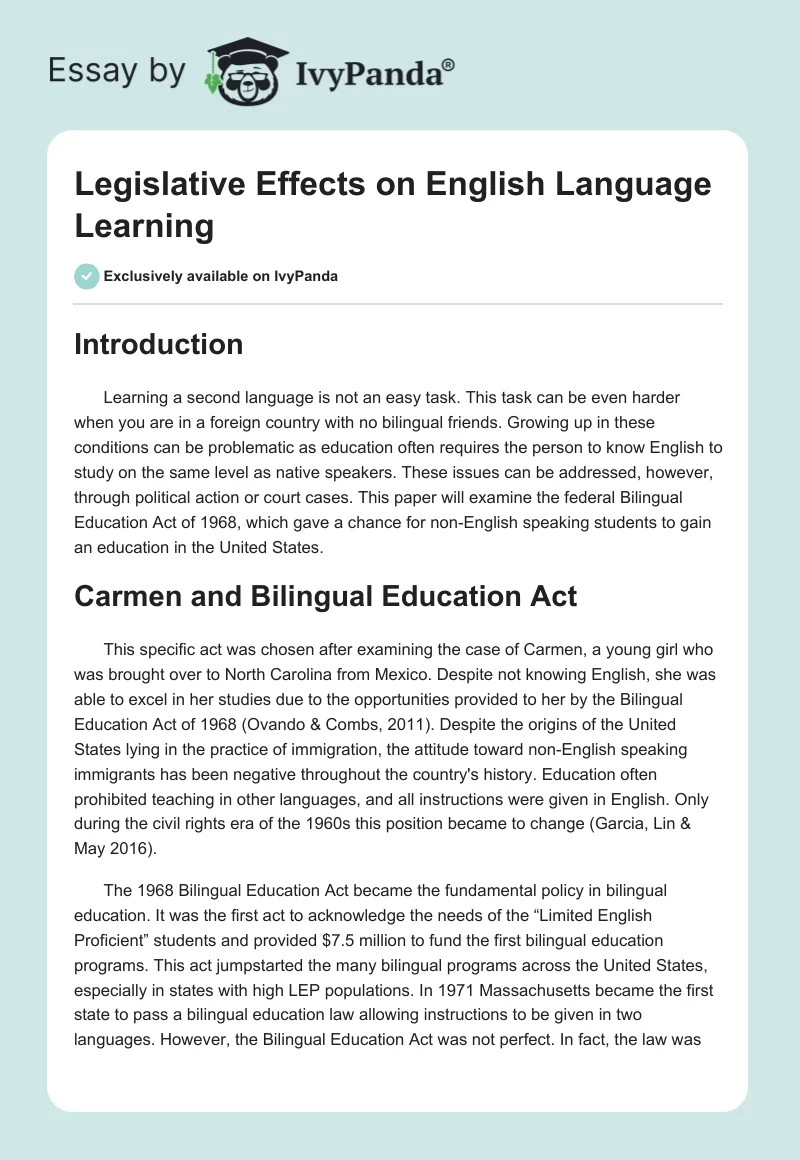Introduction
Learning a second language is not an easy task. This task can be even harder when you are in a foreign country with no bilingual friends. Growing up in these conditions can be problematic as education often requires the person to know English to study on the same level as native speakers. These issues can be addressed, however, through political action or court cases. This paper will examine the federal Bilingual Education Act of 1968, which gave a chance for non-English speaking students to gain an education in the United States.
Carmen and Bilingual Education Act
This specific act was chosen after examining the case of Carmen, a young girl who was brought over to North Carolina from Mexico. Despite not knowing English, she was able to excel in her studies due to the opportunities provided to her by the Bilingual Education Act of 1968 (Ovando & Combs, 2011). Despite the origins of the United States lying in the practice of immigration, the attitude toward non-English speaking immigrants has been negative throughout the country’s history. Education often prohibited teaching in other languages, and all instructions were given in English. Only during the civil rights era of the 1960s this position became to change (Garcia, Lin & May 2016).
The 1968 Bilingual Education Act became the fundamental policy in bilingual education. It was the first act to acknowledge the needs of the “Limited English Proficient” students and provided $7.5 million to fund the first bilingual education programs. This act jumpstarted the many bilingual programs across the United States, especially in states with high LEP populations. In 1971 Massachusetts became the first state to pass a bilingual education law allowing instructions to be given in two languages. However, the Bilingual Education Act was not perfect. In fact, the law was not clearly defined, and the goals of the programs that this act created were not outlined.
For example, it led to an issue where children of Chinese families could not gain benefits from this policy in California, which led to a large lawsuit. Despite these gaps, the law was instrumental in the further formation of bilingual programs and policies. Without its base, other states would have no ground to introduce and support bilingual education in the future. The concept of “English Language Learners” was created along with the transitional bilingual education programs that aimed to teach English to people with limited knowledge of the language. These programs would not be possible without the Bilingual Education Act allowing people to gain equal access to education (Garcia et al., 2016).
Although the policy was established a few decades ago, its positive effects are likely to benefit many ELLs in the future, as new programs can be implemented in the coming years. The results of previous evaluations have shown a considerable difference between the success of students studying under bilingual education, and the students receiving English-only instruction. New and improved programs could be created based on the analysis of these results, which would accommodate new ELLs. Unfortunately, new education standardization programs can have a negative effect on the creation of new bilingual programs, but their importance should not be underestimated (Kim, Hutchison & Winsler, 2013).
Conclusion
The importance of the Bilingual Education Act was paramount. Despite its flaws, it was responsible for the creation of countless programs to help ELLs study in the United States. The positive results suggest that it was an effective policy that contributed greatly to American education. Hopefully, its legacy will continue into the future.
References
Garcia, O., Lin, A., & May, S. (Eds.). (2016). Bilingual and multilingual education. New York, NY: Springer International Publishing.
Kim, Y., Hutchison, L., & Winsler, A. (2013). Bilingual education in the United States: An historical overview and examination of two-way immersion. Educational Review, 67(2), 236-252.
Ovando, C., & Combs, M. (2011). Bilingual and ESL classrooms. New York, NY: McGraw-Hill.


